Nour Karessli
UNICON: A unified framework for behavior-based consumer segmentation in e-commerce
Sep 18, 2023



Abstract:Data-driven personalization is a key practice in fashion e-commerce, improving the way businesses serve their consumers needs with more relevant content. While hyper-personalization offers highly targeted experiences to each consumer, it requires a significant amount of private data to create an individualized journey. To alleviate this, group-based personalization provides a moderate level of personalization built on broader common preferences of a consumer segment, while still being able to personalize the results. We introduce UNICON, a unified deep learning consumer segmentation framework that leverages rich consumer behavior data to learn long-term latent representations and utilizes them to extract two pivotal types of segmentation catering various personalization use-cases: lookalike, expanding a predefined target seed segment with consumers of similar behavior, and data-driven, revealing non-obvious consumer segments with similar affinities. We demonstrate through extensive experimentation our framework effectiveness in fashion to identify lookalike Designer audience and data-driven style segments. Furthermore, we present experiments that showcase how segment information can be incorporated in a hybrid recommender system combining hyper and group-based personalization to exploit the advantages of both alternatives and provide improvements on consumer experience.
Reusable Self-Attention-based Recommender System for Fashion
Nov 29, 2022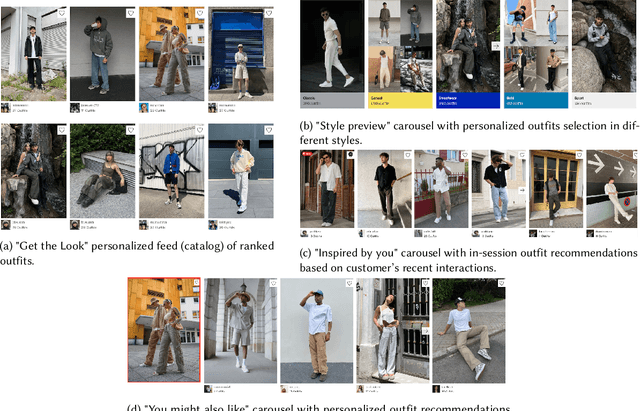
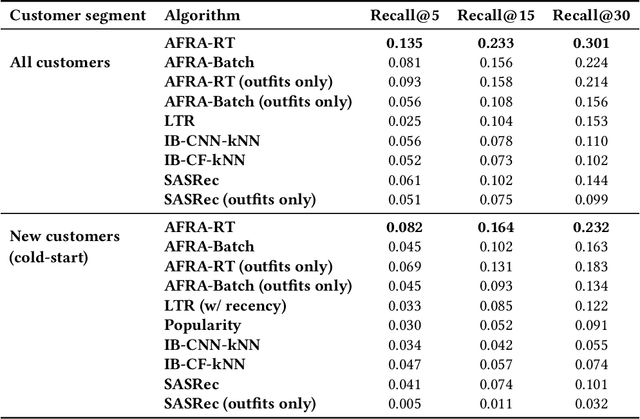


Abstract:A large number of empirical studies on applying self-attention models in the domain of recommender systems are based on offline evaluation and metrics computed on standardized datasets, without insights on how these models perform in real life scenarios. Moreover, many of them do not consider information such as item and customer metadata, although deep-learning recommenders live up to their full potential only when numerous features of heterogeneous types are included. Also, typically recommendation models are designed to serve well only a single use case, which increases modeling complexity and maintenance costs, and may lead to inconsistent customer experience. In this work, we present a reusable Attention-based Fashion Recommendation Algorithm (AFRA), that utilizes various interaction types with different fashion entities such as items (e.g., shirt), outfits and influencers, and their heterogeneous features. Moreover, we leverage temporal and contextual information to address both short and long-term customer preferences. We show its effectiveness on outfit recommendation use cases, in particular: 1) personalized ranked feed; 2) outfit recommendations by style; 3) similar item recommendation and 4) in-session recommendations inspired by most recent customer actions. We present both offline and online experimental results demonstrating substantial improvements in customer retention and engagement.
* FashionXRecSys'22: Workshop on Recommender Systems in Fashion, September 23, 2022, Seattle, WA. Parts published in RecSys 2022 (industry track)
FitGAN: Fit- and Shape-Realistic Generative Adversarial Networks for Fashion
Jun 23, 2022



Abstract:Amidst the rapid growth of fashion e-commerce, remote fitting of fashion articles remains a complex and challenging problem and a main driver of customers' frustration. Despite the recent advances in 3D virtual try-on solutions, such approaches still remain limited to a very narrow - if not only a handful - selection of articles, and often for only one size of those fashion items. Other state-of-the-art approaches that aim to support customers find what fits them online mostly require a high level of customer engagement and privacy-sensitive data (such as height, weight, age, gender, belly shape, etc.), or alternatively need images of customers' bodies in tight clothing. They also often lack the ability to produce fit and shape aware visual guidance at scale, coming up short by simply advising which size to order that would best match a customer's physical body attributes, without providing any information on how the garment may fit and look. Contributing towards taking a leap forward and surpassing the limitations of current approaches, we present FitGAN, a generative adversarial model that explicitly accounts for garments' entangled size and fit characteristics of online fashion at scale. Conditioned on the fit and shape of the articles, our model learns disentangled item representations and generates realistic images reflecting the true fit and shape properties of fashion articles. Through experiments on real world data at scale, we demonstrate how our approach is capable of synthesizing visually realistic and diverse fits of fashion items and explore its ability to control fit and shape of images for thousands of online garments.
WiCV 2021: The Eighth Women In Computer Vision Workshop
Mar 11, 2022

Abstract:In this paper, we present the details of Women in Computer Vision Workshop - WiCV 2021, organized alongside the virtual CVPR 2021. It provides a voice to a minority (female) group in the computer vision community and focuses on increasing the visibility of these researchers, both in academia and industry. WiCV believes that such an event can play an important role in lowering the gender imbalance in the field of computer vision. WiCV is organized each year where it provides a)~opportunity for collaboration between researchers from minority groups, b)~mentorship to female junior researchers, c)~financial support to presenters to overcome monetary burden and d)~large and diverse choice of role models, who can serve as examples to younger researchers at the beginning of their careers. In this paper, we present a report on the workshop program, trends over the past years, a summary of statistics regarding presenters, attendees, and sponsorship for the WiCV 2021 workshop.
SizeFlags: Reducing Size and Fit Related Returns in Fashion E-Commerce
Jun 07, 2021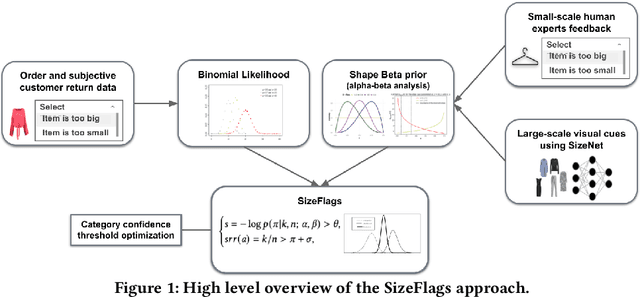
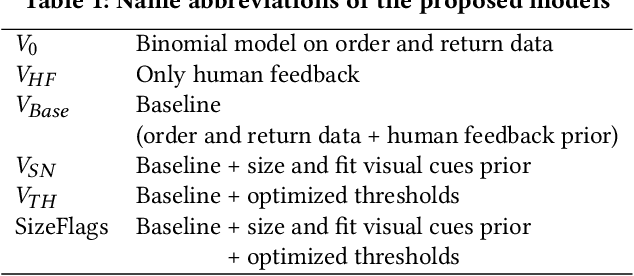
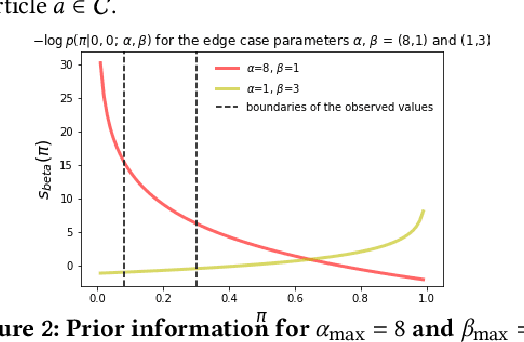

Abstract:E-commerce is growing at an unprecedented rate and the fashion industry has recently witnessed a noticeable shift in customers' order behaviour towards stronger online shopping. However, fashion articles ordered online do not always find their way to a customer's wardrobe. In fact, a large share of them end up being returned. Finding clothes that fit online is very challenging and accounts for one of the main drivers of increased return rates in fashion e-commerce. Size and fit related returns severely impact 1. the customers experience and their dissatisfaction with online shopping, 2. the environment through an increased carbon footprint, and 3. the profitability of online fashion platforms. Due to poor fit, customers often end up returning articles that they like but do not fit them, which they have to re-order in a different size. To tackle this issue we introduce SizeFlags, a probabilistic Bayesian model based on weakly annotated large-scale data from customers. Leveraging the advantages of the Bayesian framework, we extend our model to successfully integrate rich priors from human experts feedback and computer vision intelligence. Through extensive experimentation, large-scale A/B testing and continuous evaluation of the model in production, we demonstrate the strong impact of the proposed approach in robustly reducing size-related returns in online fashion over 14 countries.
WiCV 2020: The Seventh Women In Computer Vision Workshop
Jan 11, 2021

Abstract:In this paper we present the details of Women in Computer Vision Workshop - WiCV 2020, organized in alongside virtual CVPR 2020. This event aims at encouraging the women researchers in the field of computer vision. It provides a voice to a minority (female) group in computer vision community and focuses on increasingly the visibility of these researchers, both in academia and industry. WiCV believes that such an event can play an important role in lowering the gender imbalance in the field of computer vision. WiCV is organized each year where it provides a.) opportunity for collaboration with between researchers b.) mentorship to female junior researchers c.) financial support to presenters to overcome monetary burden and d.) large and diverse choice of role models, who can serve as examples to younger researchers at the beginning of their careers. In this paper, we present a report on the workshop program, trends over the past years, a summary of statistics regarding presenters, attendees, and sponsorship for the current workshop.
SizeNet: Weakly Supervised Learning of Visual Size and Fit in Fashion Images
May 28, 2019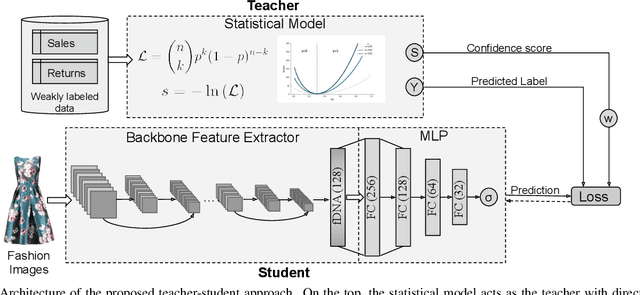
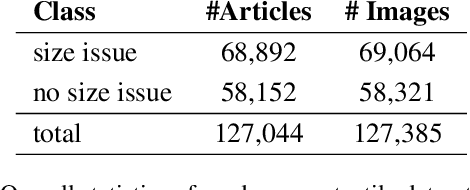
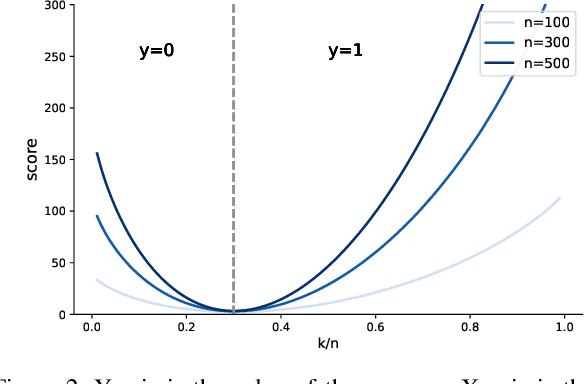
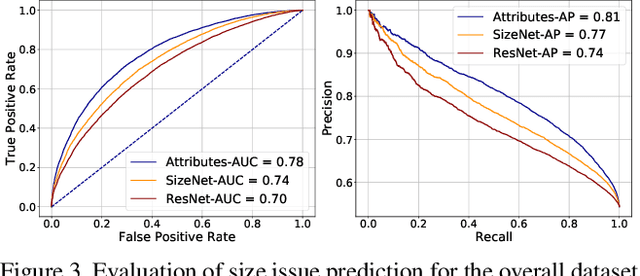
Abstract:Finding clothes that fit is a hot topic in the e-commerce fashion industry. Most approaches addressing this problem are based on statistical methods relying on historical data of articles purchased and returned to the store. Such approaches suffer from the cold start problem for the thousands of articles appearing on the shopping platforms every day, for which no prior purchase history is available. We propose to employ visual data to infer size and fit characteristics of fashion articles. We introduce SizeNet, a weakly-supervised teacher-student training framework that leverages the power of statistical models combined with the rich visual information from article images to learn visual cues for size and fit characteristics, capable of tackling the challenging cold start problem. Detailed experiments are performed on thousands of textile garments, including dresses, trousers, knitwear, tops, etc. from hundreds of different brands.
Gaze Embeddings for Zero-Shot Image Classification
Apr 12, 2017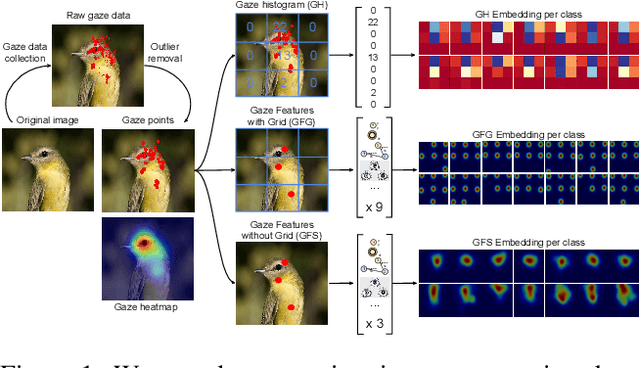

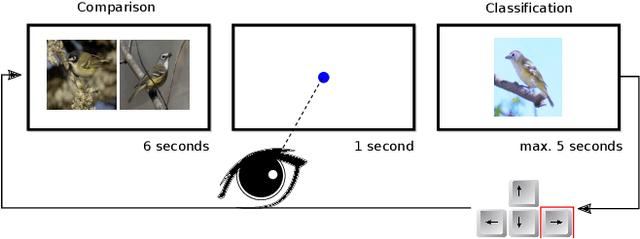
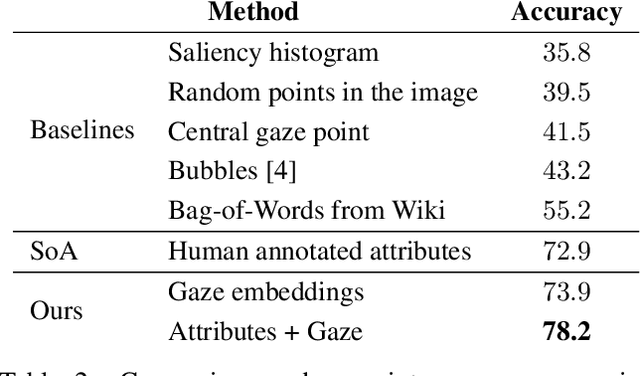
Abstract:Zero-shot image classification using auxiliary information, such as attributes describing discriminative object properties, requires time-consuming annotation by domain experts. We instead propose a method that relies on human gaze as auxiliary information, exploiting that even non-expert users have a natural ability to judge class membership. We present a data collection paradigm that involves a discrimination task to increase the information content obtained from gaze data. Our method extracts discriminative descriptors from the data and learns a compatibility function between image and gaze using three novel gaze embeddings: Gaze Histograms (GH), Gaze Features with Grid (GFG) and Gaze Features with Sequence (GFS). We introduce two new gaze-annotated datasets for fine-grained image classification and show that human gaze data is indeed class discriminative, provides a competitive alternative to expert-annotated attributes, and outperforms other baselines for zero-shot image classification.
 Add to Chrome
Add to Chrome Add to Firefox
Add to Firefox Add to Edge
Add to Edge